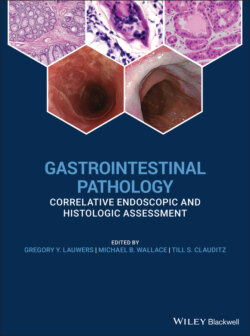Читать книгу Gastrointestinal Pathology - Группа авторов - Страница 42
Viral Esophagitis
ОглавлениеHerpes simplex (HSV) is the most common etiology of viral esophagitis, and also occurs primarily in the setting of immunosuppression, such as solid organ and bone marrow transplantation, underlying malignancy, chemotherapy, and HIV infection (AIDS). These patients may also have disseminated infection at the time of diagnosis. It can also develop in healthy adults including pregnant women and children. Both HSV types 1 and 2 can infect the esophagus with type 1 being most common. Infection by varicella‐zoster virus (VZV) may also rarely occur in immunocompromised hosts.
Figure 2.1 Endoscopic appearance of distal esophagus with normal squamous mucosa.
Figure 2.2 Normal esophagus squamous mucosa with normal stratified non‐keratinizing epithelium.
Table 2.1 Normal esophageal mucosa.
| Epithelium: |
| Non‐keratinizing squamous epithelium |
| Glycogen rich |
| 10–20 cells thick (300–500 μm) |
| Basal proliferative zone up to 15% |
| Few scattered parabasal T lymphocytes and other specialized cells |
| Lamina propria: |
| Papillary length 1/3 to 1/2 of epithelial thickness |
| Muscularis mucosae |
Cytomegalovirus (CMV)‐induced esophagitis also typically occurs in the immunosuppressed population, particularly in the setting of HIV infection/AIDS, organ transplantation, chemotherapy, corticosteroid therapy, and other forms of long‐term immunosuppression. CMV may rarely cause esophagitis in immunocompetent patients, especially in the elderly.
